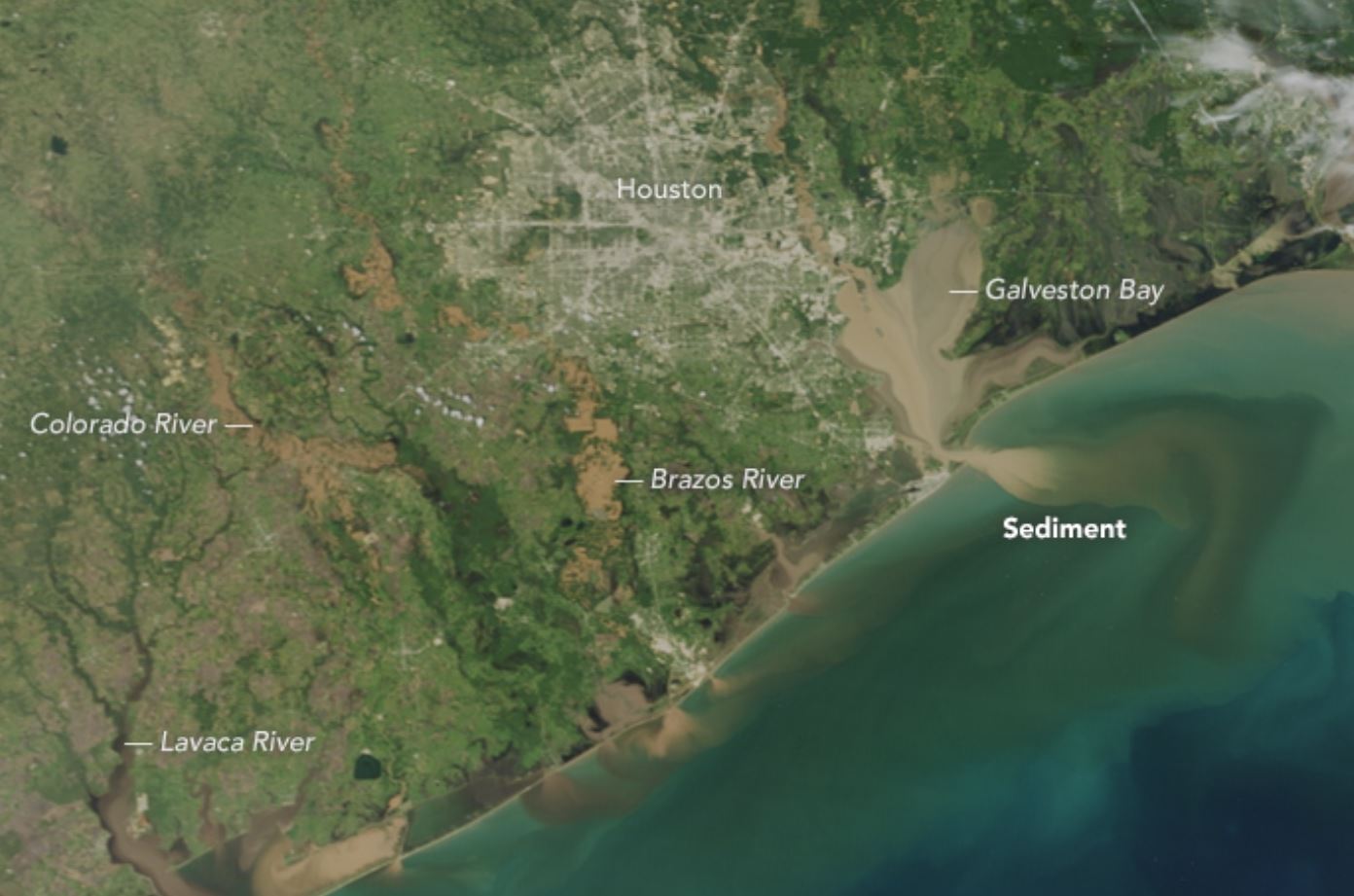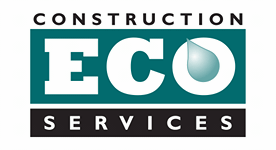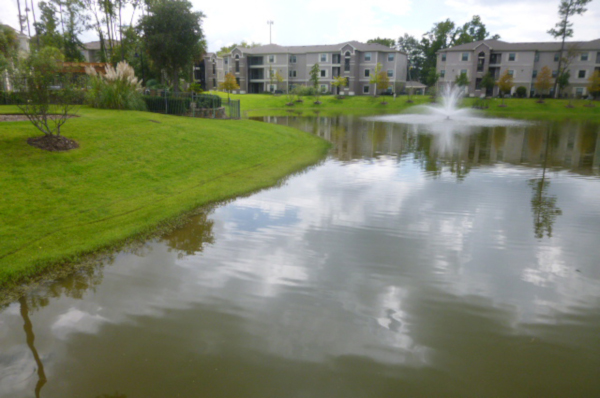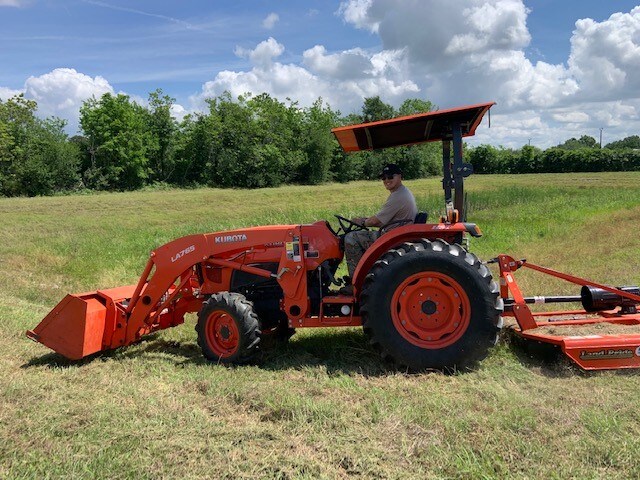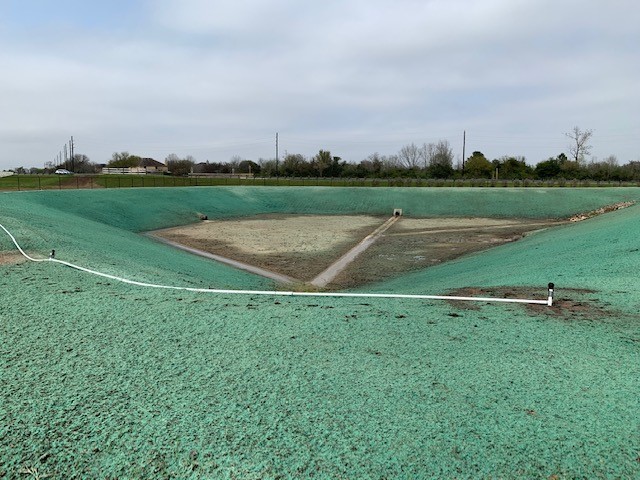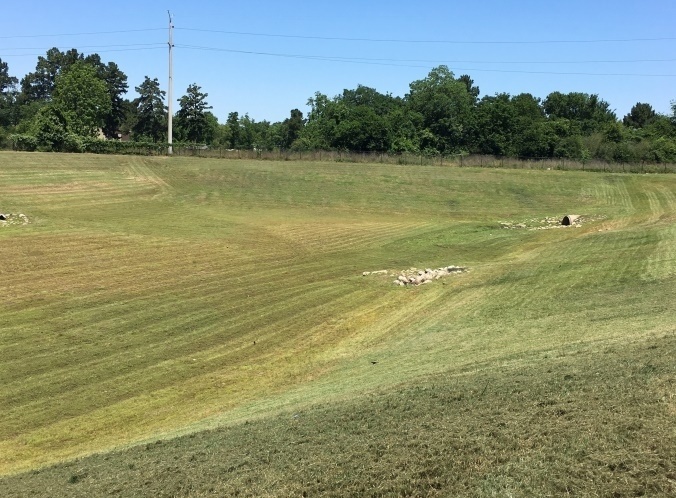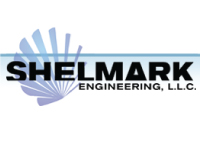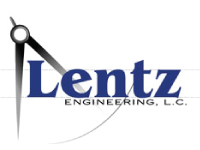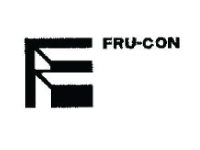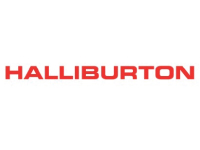Whether a Houston-Based Business, HOA, Property Manager or Private Owner, We Have Your Pond and Large Fields Maintenance Needs Covered
Do you have a large detention pond, pasture or field that needs mowing? Are you a developer who has a large plot of land that that needs to be consistently maintained? Construction EcoServices provides tractor mowing services that can get large jobs done professionally and efficiently.
Construction EcoServices provides professional pond and field mowing services throughout Houston-metro. Whether you own a large residential property or a large commercial one, Construction EcoServices has the specialized equipment to handle the job. We frequently work with property management companies, home owners associations, municipalities, and individual land owners.
We provide our clients with one time, monthly, or yearly mowing schedules. We can bill time and material, or on a flat bid basis for companies that require pond or field acreage mowing to entire subdivisions and acreage. Mowing services are offered for right of ways, ponds, large acreage, fields, single lots, and subdivisions. We can work on an “as needed” basis or we can set a schedule for regular maintenance, according to your needs / preference.
Specifically concerning detention / retention ponds, while they have many benefits, if not maintained properly they can incur great costs. Detention ponds are most often required at a development due to a large amount of impervious cover generated by the facility. That impervious cover sheds water much faster than the natural landscape. Therefore, detention ponds must be installed to regulate stormwater from leaving your site too quickly and causing greater problems downstream. These structures also help to clean water by catching trash and debris, as well as filtering out some pollutants found in stormwater.
Key Pond Maintenance Services
Pond Maintenance
Maintenance
Most often ponds are most often shallow earthern depressions but can also be extensive concrete structures as well. These ponds may have one to multiple inlets where water enters them and again, one to multiple outlets where the water can be released in a regulated manner. There may be various flow spreading structures and pilot channels that influence where the water goes in the pond. Those important outlets have necessary pieces such as drawdown pipes that are surrounded by trash racks.
Maintenance of detention ponds can most often be very simple. When small cost-effective measures are taken continuously, exorbitant costs down the road are minimized greatly. Vegetation management is the single most important task. Grass should be kept uniform in height as to protect the earthern material that makes up the walls of the pond. Roots hold the soil in place and tall, thick grass shades the soil in the heat of the summer as well as protects the grass from erosive rain events. Wall failure is a costly repair due to not protecting vegetation and wall structures. Keeping grass at a uniform height will discourage areas of stagnant water in the pond due to vegetation blocking flow.
Controlling erosion at inlets, near outlets and along walls is important as well. Detention ponds are made to catch sediment from the watershed. Sediment that has eroded from the pond only worsens the maintenance load of the pond. Keeping a healthy grass stand, not scalping while mowing and letting ponds dry before allowing equipment in will discourage erosion. Trees often are good for controlling erosion but in a pond the roots can damage underground equipment and any concrete structures therefore, tree growth should be managed.
Maintenance of the inlets and outlets will ensure the pond flows as designed. Keeping inlets and outlets as well as the associated trash racks free of mulch, trash and debris on a regular basis will help prevent drainage issues in the pond. When ponds do not drain properly, there are infrastructure problems that can arise due to water sitting in drainage piping. That water can back up in parking lots as well as sit in curb inlets. As water backs up into parking areas, there can be water infiltration in the pavement allowing cracks and potholes to form as well as the weakening of subgrade around those structures.
Detention ponds are a great stormwater management tool. Vegetation maintenance and cleaning of flow structures are quick and cost-effective techniques that can prevent catastrophic damage to your detention ponds.
Trees and other woody species are less often used in specific stormwater applications but can still be an important tool in erosion control. Trees that are very leafy and produce a lot of shade should be trimmed annually to prevent over shading turfgrass. Trees naturally shed limbs and branches as they shade themselves out. Maintaining trees often will help remove that material and keep it from clogging outlets and drains. Excess falling leaf material can shade out turfgrass and release the tree’s oils which can stunt or kill surrounding vegetation. Large trees and their root systems can damage concrete structures, underground components and liner material. Therefore, trees have their place in stormwater structures but should be managed actively and placed accordingly.
Pond Remediation
Remediation
Pond stabilization has been traditionally problematic in the Houston area as our soils are predominately clay below the first few feet and contain little organic material essential to the establishment and stability of long term vegetation. Houston also experiences intense rain events frequently. Poor soils and intense rain events combine to create conditions which encourage erosion of slopes and eventual slope failure. With our extensive erosion control experience, we can help with even the most difficult of ponds, employing the latest technologies to solve erosion problems.
Fertilizer can be applied in granules, or as a water-soluble mixture that is sprayed above ground or injected into the soil. When applying fertilizer, do not expect immediate results to poor conditions. Granule fertilizers can take up to 6 months to break down into usable nutrients by plants. Water-soluble formulations often have a more rapid affect, with results showing within a month but not lasting as long as granules. Amendments to change the soil pH are equally slow, again large changes in pH can take up to 2 years to occur. These reasons above show that a scheduled fertilization every 6 months over time will provide proper and adequate nutrition for your vegetation.
Ponds & Fields Mowing
Ponds and Fields Mowing Services
Stormwater Ponds pose a special problem for owners and property managers. Mowing slopes is much different than mowing flat ground, and requires specific equipment in order to prevent slope erosion and eventual failure requiring a costly pond remodel. We specialize in pond maintenance and take care in protecting your investment while keeping costs in check. In addition, as ponds are often located near or in large fields, we also provide mowing services for large fields and pastures.
Tree Removal
Tree Removal
Trees and other woody species are less often used in specific stormwater applications but can still be an important tool in erosion control. Trees that are very leafy and produce a lot of shade should be trimmed annually to prevent over shading turfgrass. Trees naturally shed limbs and branches as they shade themselves out. Maintaining trees often will help remove that material and keep it from clogging outlets and drains. Excess falling leaf material can shade out turfgrass and release the tree’s oils which can stunt or kill surrounding vegetation. Large trees and their root systems can damage concrete structures, underground components and liner material. Therefore, trees have their place in stormwater structures but should be managed actively and placed accordingly.
Fertilization
Fertilization
Managing fertilization of vegetation can be a daunting task but understanding the basics will help smooth out the process. Nutrient availability determines many things such as water use, re-growth, plant density and disturbance tolerance. Providing proper nutrition will help sustain your vegetation through large rain events and blistering summer droughts.
The most important task before dusting off the spreader is to perform a soil test. Soil tests are inexpensive and do not take a long time to perform. Local labs and regional universities offer soil testing services. Testing your soil will help you identify 3 important parameters: soil type, nutrient availability and soil pH. Knowing the soil type is an indicator of how the soil will drain which will determine how fast or slow nutrients can be held in the soil for plant use. Nutrient availability will identify what nutrients are there and give you an idea of what to add. Finally, soil pH is also a major factor in determining fertilizer requirements as you may have to treat the soil the change the pH for the desired vegetation.
After you have done a soil test, you can select your vegetation type. Grasses, shrubs and trees all will require different levels and types of nutrients so closely review those requirements and recommendations for the parameters, soil type, nutrient composition and soil pH. Now, let’s fertilize the soil for your new plantings or existing vegetation. Fertilizer is often formulated in a ratio of 3 parts, Nitrogen, Phosphorous and Potassium or NPK for short. On a bag of fertilizer, it will have a line of 3 numbers, similar to 10-15-5, that is the ratio of NPK. Using the soil test and your desired vegetation requirements, select the proper formulation to remedy your soils. Most garden supply centers can also decipher the soil test requirements as well. Using the soil test again, there may be requirements to change the pH of your soil, in which there are certain amendments to achieve this.
Fertilizer can be applied in granules, or as a water-soluble mixture that is sprayed above ground or injected into the soil. When applying fertilizer, do not expect immediate results to poor conditions. Granule fertilizers can take up to 6 months to break down into usable nutrients by plants. Water-soluble formulations often have a more rapid affect, with results showing within a month but not lasting as long as granules. Amendments to change the soil pH are equally slow, again large changes in pH can take up to 2 years to occur. These reasons above show that a scheduled fertilization every 6 months over time will provide proper and adequate nutrition for your vegetation.
Pump Repair or Replacement
Pump Repair or Replacement
Nothing mechanical last forever, certainly not pumps. There are many factors that determine the lifespan of a stormwater pond pump, but among the most notable are choosing the right pump for the job and then the ongoing maintenance of the chosen pump. Both of which Construction EcoServices is here to help you with.
If your pump has stopped working, give us call. We will gladly come out to provide you a free assessment of your pump to determine whether it needs repair or replacement, as well as to inform you of your next step options.
All Pond and Field Maintenance Services We Can Provide
- Mowing
- Overseeding
- Fertilizing
- Erosion Control
- Tree Removal
- Regrading
- Pilot Channel Cleanouts and Maintenance
- Trash Rack Cleanouts and Maintenance
- Pump Repair and Replacement
Received a Re-Permit Notice, What Next?
Learn what to do next if you have received a Notice of Stormwater Quality Requirements for your property. Harris County and the City of Houston each have a set of regulations regarding the post-construction stormwater management obligations that must be met by property owners.
- Determine if your property is in permittable condition
- Issues that must be resolved prior to re-permit
- Professional Engineer Certification
- How to avoid the cost of non-compliance
With an understanding of your requirements as a property owner or manager, this guide will go a long way towards insuring your property is compliant with stormwater quality regulations.
Featured Blog Post
MAKING A CASE TO MAINTAIN YOUR POND REGULARLY
Do detention ponds need to be maintained regularly? In short, yes. Ponds need to be maintained with some regularity if one intends to keep the pond operating as expected and one appreciates increasing the odds of NOT encountering extraordinary costly issues down the road.
WHY SHOULD YOU CARE?
Stormwater Quality (SWQ) permitting regulations exist to improve water quality and to minimize negative impacts of development on our watersheds. Without these programs, the effects that a growing community creates would have a devastating impact on our region’s already impaired rivers, streams and bayous. Counties and cities each have their own set of regulations regarding the post-construction stormwater management obligations that must be met by property owners.
When incorporating the specifics of SWQ regulatory requirements into the design of a development, the civil engineer calculates the volume of water to be treated, creates a Stormwater Quality Management Plan SWQ and selects a stormwater quality treatment feature to fit the needs of the site. The resulting design must be approved by County or City engineers and a Stormwater Quality Permit is issued to the Owner of the property.
All of this happens before construction is permitted or commenced. On occasion, the SWQ permit and the SWQMP which guides compliance; are details the property Owner or Manager may not be fully aware of. If the SWQ permit is not renewed annually as required, and/or the stormwater quality feature is not inspected and maintained according to the SWQMP, the property Owner is out of compliance and will be subject to fines.
Some may see stormwater management as just another unnecessary and unwanted cost to construction projects or property ownership and management. But, understanding the negative effects that poor or no stormwater management is causing should be a concern to us all. It affects where we live and play. It affects our marine-based food supply. It affects our dwindling water supply.
We care. It is why we do what we do.
